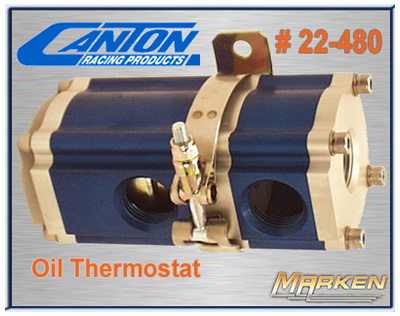 Canton’s Oil Thermostat # 22-480 thru Marken Performance helps your engine reach and maintain an optimal oil temperature. This is key for the long life and performance of an engine’s internal components, and while it’s certainly key for your daily driver, it’s absolutely vital for high performance vehicles with built engines, where RPM’s tend to be higher and the parts and pieces that comprise the rotating assembly are finished with tight tolerances.
Canton’s Oil Thermostat # 22-480 thru Marken Performance helps your engine reach and maintain an optimal oil temperature. This is key for the long life and performance of an engine’s internal components, and while it’s certainly key for your daily driver, it’s absolutely vital for high performance vehicles with built engines, where RPM’s tend to be higher and the parts and pieces that comprise the rotating assembly are finished with tight tolerances. “The most important rule of thumb is that, for every 10 degrees Celsius (or 18 degrees Fahrenheit) that you increase your oil temperature, you cut the oil’s useful life in half,” explains Lake Speed of Driven. “And that’s basically in terms of the oil’s ability to withstand temperature and not break down.” Speed continues, “This is just a fact of life when it comes to engine oil, and the solution sounds easy — you just keep the oil cold. But when your oil is below 212 degrees Fahrenheit — the boiling point of water — you’re building up moisture in your crankcase. In the combustion process, every time there’s a cycle, water vapor is produced. You then have blow-by, which all engines are victims of to some degree, thus you’re going to have some level of moisture built up inside the crankcase.”
To alleviate the creation of excessive moisture, the optimal operating range of engine oil is no less than 212 degrees, which is the point at which the water in the oil will evaporate. Vehicles with an oil temperature thermostat (which we’re going to discuss here shortly) are typically set right at or slightly above this mark. Conversely, you don’t want to run the oil above roughly 240 degrees, as Speed tells us, because you begin to significantly reduce the life and operating ability of the oil, as oil containing moisture doesn’t flow or lubricate properly.
The Canton Racing oil thermostat operates using a standard, thermostatic wax element rated at 215-degrees that partially opens an internal valve to the cooler at 215 degrees and fully at 230 (about 1/4-inch of travel), with a reaction speed from partial to fully open ranging from 2.5 to seven minutes, depending on the type of oil and the temperature it’s at. Below 215 degrees, the valve remains closed, bypassing the oil from the cooler and directly back to the engine so that it can cycle through and heat up to the optimum range. Canton’s oil cooler thermostat is a durable piece machined from a 3-1/4-inch square 6061 T-6 aluminum extrusion, and measures six inches in height. It comes with a black and clear anodized finish, with a stainless mounting clamp. The four oil inlet/outlet ports fit a 1-1/16-inch, -12 O-ring fitting. This thermostat can be mounted in any orientation you desire to cater the plumbing to your needs.
By using a thermostat paired with the cooler, you can get the oil heated up above the oxydation point quicker and, once there, keep it at the sweet spot of 212 to 240 degrees.
Shop Canton Racing in Canada & USA, Marken Performance 1-888-401-1362
News
- Mar 26 2019 EBC New RP-1 Brake Pads for Racing
- Mar 11 2019 Bushwacker DRT Style™ Fender Flares
- Feb 23 2019 Flowmaster Cat-Back 717889 fits 2019 RAM 1500 Hemi
- Feb 11 2019 Optima Yellowtop Rectangle Battery # 9048-148, H6 Group 48
- Jan 18 2019 Holley New Larger EFI Pro Dash
- Jan 08 2019 Lucas Oil Low Viscosity Stabilizer #11097 + #11096 Intake Cleaner for Gasoline Direct Injection Engines
- May 05 2018 Thermo-Tech Rogue Series T3, T4 Turbo Cover
- Apr 30 2018 Holley’s Mid-Mount Kit # 20-200 for LT Swap, with accessories
- Apr 27 2018 SCT BDX Performance Programmer + Monitor + Adjustments
- Apr 23 2018 ReadyLift 7 inch Lift for 2014_UP Chevy 1500
Industry News
Loading


You must login to post comments.